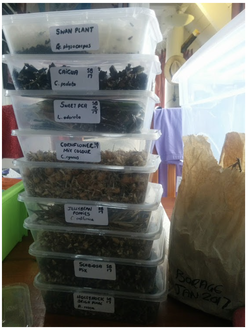|
By Minette Tonoli www.meadowsweet.co.nz It is mid autumn, and my world seems to be a great big mess at the moment – my herb, flower and vegetable gardens look a bit ramshackle and dishevelled, and my dining room table is strewn with a cacophony of bags, boxes, baskets and buckets. And I can’t be any happier! Why? It’s seed-saving time, of course! I am a seed fanatic. I experience elation and euphoria when I get new seeds over the post, wait in nail-biting anticipation for the latest seed-catalogues to arrive, and get a bit crazy-eyed when I wander into my garden to find ripening seed pods. I obsessively pack, sort out and move my seeds around, and cannot imagine my life without my seed boxes. Confession: I even have a “Seed Collecting Kit” in my handbag – complete with baggies, labels, a permanent marker, and mini secateurs, you know, just in case I run into some seeds that desperately need to be collected… I am not the only seed obsessed person either, I know from my connections in the plant world that there are lots of people who hyperventilate just a bit when the topic of seeds comes up. “Hello everyone, I am Minette, and I am a seedaholic.” Please, don’t get me wrong, I’m not belittling addiction, and know full well how devastating an addiction can be – I count myself very lucky indeed that my addiction tendencies happened to fall onto what can be considered a healthy pursuit. I thought I’d give a few thoughts and pointers on collecting and saving seeds as autumn gathers momentum and summer producing plants tend toward making seeds. The best time Most plants seem to have their seeds ripen during late summer, and the best time to start collecting a good variety of seed is in early autumn, but really it is the best time whenever the seeds you want to collect are fully ripe and dry - whatever the season. Pips and seeds from fruit and vegetables can be saved as the produce is harvested. The best kind Organic If you are into pure organics, then seeds from an organically managed environment are important to you. These seeds won’t have any pesticide or herbicide residue on them, and claims are that they could produce more robust plants that are already adapted to organic growing conditions. Personally, while I grow my plants using organic principles, I’m not a stickler for organically produced seeds. Productive Genetically it makes sense to “breed from the best”, and if you have a particular plant that does really well in your garden, or find a magnificent specimen in someone else’s, it stands to reason that seeds from those will produce similar strong offspring. Local It is believed that saving the seeds from plants growing in and around your immediate area will result, over time, in plants that are better adapted to that environment. . Non-hybrid Hybrids are plants that are specifically bred for particular traits (such as a low growing habit, flower colour, greater fruit production etc.) Hybrid seeds are NOT GMOs (genetically modified), but simply the result from the manipulation of pollination. The reason why hybrids, in particular F1 hybrids (first familial hybrids) are not good to save seed from, is that they generally don’t produce true to type. This means that if you grow a plant from an F1 hybrid, and save seed from it, the plants resulting from those seeds will most probably not look or produce the same as the original F1 that you had. Sometimes the gamble is worth it though – below (left) is a picture of a sunflower I grew from seeds saved from the F1 red/bronze hybrid called “Moulin Rouge” (pictured right). Pure And here I am particularly noting plants that readily cross-pollinate between cultivars, and which may have seeds which will not result in a desirable offspring. Plants that need to have a good space between different varieties to ensure proper seed saving practices include pumpkins and squashes, brassicas such as cauliflower, broccoli, and cabbage, different chilli cultivars within the same species, and some flowers.
Asking permission… or forgiveness
Gardeners are generally quite giving folk, and unless they run a nursery from home, or have a jealously guarded home-bred cultivar, they’ll be happy (and flattered) to give you some of the seeds from plants in their garden. I have found over the years that asking is better, but know there are many stealthy seed snatchers out there too! Creative improvisation Unless you are well prepared and have all the goodies at the ready, you sometimes find yourself with an opportunity to collect seeds and must make do with whatever you can find to keep the seeds safe – a napkin, empty mint tin, till receipt and coin purse make a quick seed saving packet in a pinch. Sharing is caring There’s a seed savers group around every corner, and in all corners of the country, so get connected, meet up, exchange seeds and get growing! References
0 Comments
Leave a Reply. |
AuthorWrite something about yourself. No need to be fancy, just an overview. ArchivesCategories |


 RSS Feed
RSS Feed